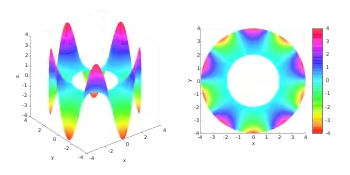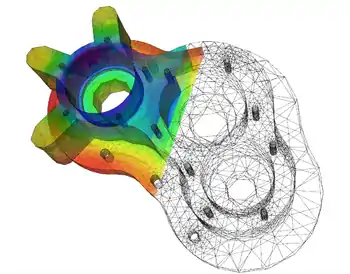Differential operator
In mathematics, a differential operator is an operator defined as a function of the differentiation operator. It is helpful, as a matter of notation first, to consider differentiation as an abstract operation that accepts a function and returns another function (in the style of a higher-order function in computer science).

This article considers mainly linear operators, which are the most common type. However, non-linear differential operators, such as the Schwarzian derivative also exist.
Definition
Assume that there is a map from a function space to another function space and a function so that is the image of i.e., A differential operator is represented as a linear combination, finitely generated by and its derivatives containing higher degree such as
where the set of non-negative integers, , is called a multi-index, called length, are functions on some open domain in n-dimensional space and The derivative above is one as functions or, sometimes, distributions or hyperfunctions and or sometimes, .
Notations
The most common differential operator is the action of taking derivative. Common notations for taking the first derivative with respect to a variable x include:
- and
When taking higher, nth order derivatives, the operator may also be written:
- , or .
The derivative of a function f of an argument x is sometimes given as either of the following:
The D notation's use and creation is credited to Oliver Heaviside, who considered differential operators of the form
in his study of differential equations.
One of the most frequently seen differential operators is the Laplacian operator, defined by
Another differential operator is the Θ operator, or theta operator, defined by[1]
This is sometimes also called the homogeneity operator, because its eigenfunctions are the monomials in z:
In n variables the homogeneity operator is given by
As in one variable, the eigenspaces of Θ are the spaces of homogeneous polynomials.
In writing, following common mathematical convention, the argument of a differential operator is usually placed on the right side of the operator itself. Sometimes an alternative notation is used: The result of applying the operator to the function on the left side of the operator and on the right side of the operator, and the difference obtained when applying the differential operator to the functions on both sides, are denoted by arrows as follows:
Such a bidirectional-arrow notation is frequently used for describing the probability current of quantum mechanics.
Del
The differential operator del, also called nabla operator, is an important vector differential operator. It appears frequently in physics in places like the differential form of Maxwell's equations. In three-dimensional Cartesian coordinates, del is defined:
Del defines the gradient, and is used to calculate the curl, divergence, and Laplacian of various objects.
Adjoint of an operator
Given a linear differential operator T
the adjoint of this operator is defined as the operator such that
where the notation is used for the scalar product or inner product. This definition therefore depends on the definition of the scalar product.
Formal adjoint in one variable
In the functional space of square-integrable functions on a real interval (a, b), the scalar product is defined by
where the line over f(x) denotes the complex conjugate of f(x). If one moreover adds the condition that f or g vanishes for x → a and x → b, one can also define the adjoint of T by
This formula does not explicitly depend on the definition of the scalar product. It is therefore sometimes chosen as a definition of the adjoint operator. When T* is defined according to this formula, it is called the formal adjoint of T.
A (formally) self-adjoint operator is an operator equal to its own (formal) adjoint.
Several variables
If Ω is a domain in Rn, and P a differential operator on Ω, then the adjoint of P is defined in L2(Ω) by duality in the analogous manner:
for all smooth L2 functions f, g. Since smooth functions are dense in L2, this defines the adjoint on a dense subset of L2: P* is a densely defined operator.
Example
The Sturm–Liouville operator is a well-known example of a formal self-adjoint operator. This second-order linear differential operator L can be written in the form
This property can be proven using the formal adjoint definition above.
This operator is central to Sturm–Liouville theory where the eigenfunctions (analogues to eigenvectors) of this operator are considered.
Properties of differential operators
Differentiation is linear, i.e.,
where f and g are functions, and a is a constant.
Any polynomial in D with function coefficients is also a differential operator. We may also compose differential operators by the rule
Some care is then required: firstly any function coefficients in the operator D2 must be differentiable as many times as the application of D1 requires. To get a ring of such operators we must assume derivatives of all orders of the coefficients used. Secondly, this ring will not be commutative: an operator gD isn't the same in general as Dg. In fact we have for example the relation basic in quantum mechanics:
The subring of operators that are polynomials in D with constant coefficients is, by contrast, commutative. It can be characterised another way: it consists of the translation-invariant operators.
The differential operators also obey the shift theorem.
Several variables
The same constructions can be carried out with partial derivatives, differentiation with respect to different variables giving rise to operators that commute (see symmetry of second derivatives).
Ring of polynomial differential operators
Ring of univariate polynomial differential operators
If R is a ring, let be the non-commutative polynomial ring over R in the variable D and X, and I the two-sided ideal generated by DX-XD-1, then the ring of univariate polynomial differential operators over R is the quotient ring . This is a non-commutative simple ring. Every element can be written in a unique way as a R-linear combination of monomials of the form . It supports an analogue of the Euclidean division of polynomials.
Differential modules over (for the standard derivation) can be identified with modules over .
Ring of multivariate polynomial differential operators
If R is a ring, let be the non-commutative polynomial ring over R in the variables , and I the two-sided ideal generated by the elements
for all where is Kronecker delta, then the ring of multivariate polynomial differential operators over R is the quotient ring .
This is a non-commutative simple ring. Every elements can be written in a unique way as a R-linear combination of monomials of the form .
Coordinate-independent description
In differential geometry and algebraic geometry it is often convenient to have a coordinate-independent description of differential operators between two vector bundles. Let E and F be two vector bundles over a differentiable manifold M. An R-linear mapping of sections P : Γ(E) → Γ(F) is said to be a kth-order linear differential operator if it factors through the jet bundle Jk(E). In other words, there exists a linear mapping of vector bundles
such that
where jk: Γ(E) → Γ(Jk(E)) is the prolongation that associates to any section of E its k-jet.
This just means that for a given section s of E, the value of P(s) at a point x ∈ M is fully determined by the kth-order infinitesimal behavior of s in x. In particular this implies that P(s)(x) is determined by the germ of s in x, which is expressed by saying that differential operators are local. A foundational result is the Peetre theorem showing that the converse is also true: any (linear) local operator is differential.
Relation to commutative algebra
An equivalent, but purely algebraic description of linear differential operators is as follows: an R-linear map P is a kth-order linear differential operator, if for any k + 1 smooth functions we have
Here the bracket is defined as the commutator
This characterization of linear differential operators shows that they are particular mappings between modules over a commutative algebra, allowing the concept to be seen as a part of commutative algebra.
Examples
- In applications to the physical sciences, operators such as the Laplace operator play a major role in setting up and solving partial differential equations.
- In differential topology the exterior derivative and Lie derivative operators have intrinsic meaning.
- In abstract algebra, the concept of a derivation allows for generalizations of differential operators, which do not require the use of calculus. Frequently such generalizations are employed in algebraic geometry and commutative algebra. See also jet (mathematics).
- In the development of holomorphic functions of a complex variable z = x + i y, sometimes a complex function is considered to be a function of two real variables x and y. Use is made of the Wirtinger derivatives, which are partial differential operators:
This approach is also used to study functions of several complex variables and functions of a motor variable.
History
The conceptual step of writing a differential operator as something free-standing is attributed to Louis François Antoine Arbogast in 1800.[2]
See also
References
- E. W. Weisstein. "Theta Operator". Retrieved 2009-06-12.
- James Gasser (editor), A Boole Anthology: Recent and classical studies in the logic of George Boole (2000), p. 169; Google Books.
External links
 Media related to Differential operators at Wikimedia Commons
Media related to Differential operators at Wikimedia Commons- "Differential operator", Encyclopedia of Mathematics, EMS Press, 2001 [1994]
